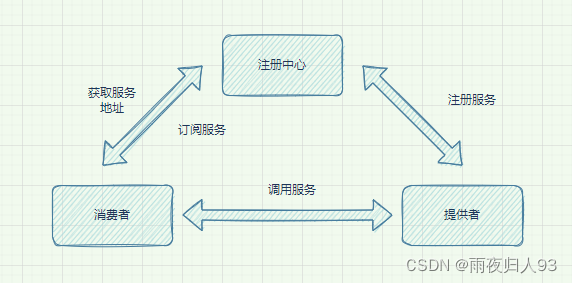本篇开始准备手打一个简易的RPC框架。
主要实现功能:
- 序列化通信
自定义通信协议,进行rpc序列化以及反序列化 - 动态注入
服务启动自动注入消费者以及提供者 - 注册中心
注册中心获取服务,并监听服务变化 - 拦击器功能
提供请求响应拦截功能,提供扩展接口 - 负载均衡
实现客户端对服务的负载均衡功能
整体流程如下:

本章主要实现序列化功能,这里以Netty为核心进行构建。
一.pom依赖
jdk为1.8,pom 文件依赖如下:
<properties>
<netty-version>4.1.74.Final</netty-version>
<protostuff-version>1.7.4</protostuff-version>
<spring-framework.version>5.2.12.RELEASE</spring-framework.version>
<fastjson.version>1.2.72</fastjson.version>
<slf4j.version>1.7.30</slf4j.version>
</properties>
<dependencies>
<dependency>
<groupId>org.springframework</groupId>
<artifactId>spring-context</artifactId>
<version>${spring-framework.version}</version>
</dependency>
<dependency>
<groupId>com.alibaba</groupId>
<artifactId>fastjson</artifactId>
<version>${fastjson.version}</version>
</dependency>
<dependency>
<groupId>io.netty</groupId>
<artifactId>netty-all</artifactId>
<version>${netty-version}</version>
</dependency>
<dependency>
<groupId>io.protostuff</groupId>
<artifactId>protostuff-core</artifactId>
<version>${protostuff-version}</version>
</dependency>
<dependency>
<groupId>io.protostuff</groupId>
<artifactId>protostuff-runtime</artifactId>
<version>${protostuff-version}</version>
</dependency>
<dependency>
<groupId>org.slf4j</groupId>
<artifactId>slf4j-api</artifactId>
<version>${slf4j.version}</version>
</dependency>
</dependencies>
二. 实现客户端启动类
客户端代码如下:
public class NettyClientTask implements Runnable {
private final Logger log = LoggerFactory.getLogger(this.getClass());
public ChannelFuture channelFuture;
private final String ip;
private final int port;
public NettyClientTask(String ip, int port) {
this.ip = ip;
this.port = port;
}
@Override
public void run() {
// 创建线程组
NioEventLoopGroup group = new NioEventLoopGroup();
try {
Bootstrap bootStrap = new Bootstrap();
bootStrap.group(group)
// 通道类型
.channel(NioSocketChannel.class)
.option(ChannelOption.SO_KEEPALIVE, true)
.option(ChannelOption.AUTO_READ, true)
// 设置管道上的处理器
.handler(new ChannelInitializer<SocketChannel>(){
@Override
protected void initChannel(SocketChannel socketChannel) throws Exception {
socketChannel.pipeline()
.addLast(new DataDecoder(Response.class))
.addLast(new DataEncoder(Request.class))
.addLast(new ClientHandle());
}
});
log.info("开始启动客户端...");
channelFuture = bootStrap.connect(ip, port).sync();
log.info("启动客户端结束");
channelFuture.channel().closeFuture().sync();
} catch (InterruptedException e) {
log.error("客户端启动异常",e);
} finally {
group.shutdownGracefully();
}
}
}
三. 实现服务端启动类
服务端启动类代码如下:
public class NettyServerTask implements Runnable{
private final Logger log = LoggerFactory.getLogger(this.getClass());
public static ChannelFuture channelFuture;
private final String ip;
private final int port;
public NettyServerTask(String ip, int port) {
this.ip = ip;
this.port = port;
}
@Override
public void run() {
// 创建线程组,bossGroup用于接收连接,workGroup用于处理读写事件
EventLoopGroup bossGroup = new NioEventLoopGroup();
EventLoopGroup workGroup = new NioEventLoopGroup();
try{
ServerBootstrap bootstrap = new ServerBootstrap();
bootstrap.group(bossGroup, workGroup)
// 通道类型
.channel(NioServerSocketChannel.class)
.option(ChannelOption.SO_BACKLOG, 128)
.childOption(ChannelOption.SO_REUSEADDR, Boolean.TRUE)
.childOption(ChannelOption.SO_KEEPALIVE, true)
// 设置管道上的处理器
.childHandler(new ChannelInitializer<SocketChannel>(){
@Override
protected void initChannel(SocketChannel socketChannel) throws Exception {
socketChannel.pipeline()
.addLast(new DataDecoder(Request.class))
.addLast(new DataEncoder(Response.class))
.addLast(new ServerHandle());
}
});
log.info("开始启动服务端...");
channelFuture = bootstrap.bind(ip,port).sync();
log.info("启动服务端结束");
channelFuture.channel().closeFuture().sync();
} catch (InterruptedException e) {
log.error("客户端启动异常",e);
} finally{
workGroup.shutdownGracefully();
bossGroup.shutdownGracefully();
}
}
}
四. 处理器
自定义Netty处理器,实现读写事件功能。
- 客户端处理器如下:
public class ClientHandle extends ChannelInboundHandlerAdapter {
@Override
public void channelRead(ChannelHandlerContext ctx, Object msg) throws Exception {
Response response = (Response) msg;
RainFuture future = ConsumerContext.RESULT_MAP.get(response.getId());
if (future != null) {
future.setResponse(response);
}else{
throw new RuntimeException("未找到对应future");
}
}
@Override
public void exceptionCaught(ChannelHandlerContext ctx, Throwable cause) throws Exception {
super.exceptionCaught(ctx, cause);
ctx.close();
}
}
- 服务端处理器如下:
public class ServerHandle extends ChannelInboundHandlerAdapter {
@Override
public void channelRead(ChannelHandlerContext ctx, Object msg) throws Exception {
Request request= (Request) msg;
try {
Object result = ProviderContext.exec(request.getClassName(), request.getMethodName(), request.getData());
Response response = Response.success(request.getId());
response.setData(result);
ctx.writeAndFlush(response);
} catch (Exception e) {
Response response = Response.error(request.getId());
response.setMsg(e.getMessage());
response.setCause(e);
ctx.writeAndFlush(response);
}
}
}
四. 自定义通信协议
rpc通信协议和Http协议比较,目前主要区别是通用性上。rpc协议有一套自有的规则,类似方言,黑话,其他协议规则无法进行解析。
通信规则:
- 定义请求头
对于请求头,可以指定请求的协议类型,版本号信息,过滤非约定的请求 - 定义序列化规则
序列以及反序列,这里采用protostuff处理。它是Protocol Buffer 的包装版,比Protocol Buffer 更加易用,而且继承了Protocol Buffer 的高性能特点。
- 数据序列化处理器:
public class DataEncoder extends MessageToByteEncoder {
private Class<?> genericClass;
public DataEncoder(Class<?> genericClass) {
this.genericClass = genericClass;
}
@Override
protected void encode(ChannelHandlerContext channelHandlerContext, Object o, ByteBuf byteBuf) throws Exception {
byte[] bytes = SerializeUtil.serialize(o);
// 模拟请求头,协议类型等数据
byteBuf.writeInt(1);
byteBuf.writeInt(bytes.length);
byteBuf.writeBytes(bytes);
}
}
- 数据反序列化处理器:
public class DataDecoder extends ByteToMessageDecoder {
private Class<?> genericClass;
public DataDecoder(Class<?> genericClass) {
this.genericClass = genericClass;
}
@Override
protected void decode(ChannelHandlerContext channelHandlerContext, ByteBuf buf, List<Object> list) throws Exception {
// 1个int对应4个字节
if (buf.readableBytes() < 8) {
return;
}
buf.markReaderIndex();
// 处理版本号等
int header = buf.readInt();
if (header != 1) {
throw new RuntimeException("不支持当前请求");
}
int dataLength = buf.readInt();
if (buf.readableBytes() < dataLength) {
buf.resetReaderIndex();
return;
}
byte[] data = new byte[dataLength];
buf.readBytes(data);
list.add(SerializeUtil.deserialize(data, genericClass));
}
}
如何处理半包和粘包问题?
数据传输以字节流的形式进行的。
如果没标识,服务程序是无法辨别流的开始和结束,可能导致流数据不完整的情况。
本例对于这种情况,采用传输总字节大小方式,告诉服务接收端,数据大小。当然也可以采用特殊字符,作为标识的方式。
序列化工具类如下:
public class SerializeUtil {
private final static LinkedBuffer BUFFER = LinkedBuffer.allocate(LinkedBuffer.DEFAULT_BUFFER_SIZE);
private final static Map<Class<?>, Schema<?>> SCHEMA_CACHE = new ConcurrentHashMap<>();
/**
* 序列化方法,把指定对象序列化成字节数组
* @param obj
* @return {@link byte[]}
*/
@SuppressWarnings("unchecked")
public static <T> byte[] serialize(T obj) {
Class<T> clazz = (Class<T>) obj.getClass();
Schema<T> schema = getSchema(clazz);
byte[] data;
try {
data = ProtostuffIOUtil.toByteArray(obj, schema, BUFFER);
} finally {
BUFFER.clear();
}
return data;
}
/**
* 反序列化方法,将字节数组反序列化成指定Class类型
* @param data
* @param clazz
* @return {@link T}
*/
public static <T> T deserialize(byte[] data, Class<T> clazz) {
Schema<T> schema = getSchema(clazz);
T obj = schema.newMessage();
ProtostuffIOUtil.mergeFrom(data, obj, schema);
return obj;
}
@SuppressWarnings("unchecked")
private static <T> Schema<T> getSchema(Class<T> clazz) {
Schema<T> schema = (Schema<T>) SCHEMA_CACHE.get(clazz);
if (Objects.isNull(schema)) {
schema = RuntimeSchema.getSchema(clazz);
SCHEMA_CACHE.put(clazz, schema);
}
return schema;
}
}






















 258
258











 被折叠的 条评论
为什么被折叠?
被折叠的 条评论
为什么被折叠?








